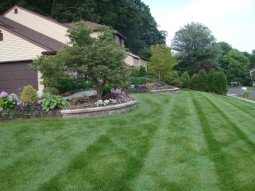 Lawn aeration boosts the health of the grass and soil of your lawn by easing compacted pressure and allowing nutrients and water to more easily circulate through the soil. Because of better nutrient and water circulation and penetration, aeration also allows for the grass roots to grow deeper. Because of better water penetration, aerating can also help you save on your water bill; with more water getting to your grass, the amount of watering you need to do simultaneously decreases. Aeration can also be very helpful in preventing diseases. Lawns that typically are very demanding in terms of aeration include ones with clay soils or ones that deal with frequent and abundant foot traffic. If your grass is looking rather weak, and water doesn’t easily penetrate the surface, it’s likely that your lawn is due for aeration.
Lawn aeration boosts the health of the grass and soil of your lawn by easing compacted pressure and allowing nutrients and water to more easily circulate through the soil. Because of better nutrient and water circulation and penetration, aeration also allows for the grass roots to grow deeper. Because of better water penetration, aerating can also help you save on your water bill; with more water getting to your grass, the amount of watering you need to do simultaneously decreases. Aeration can also be very helpful in preventing diseases. Lawns that typically are very demanding in terms of aeration include ones with clay soils or ones that deal with frequent and abundant foot traffic. If your grass is looking rather weak, and water doesn’t easily penetrate the surface, it’s likely that your lawn is due for aeration.
If you want to know whether your lawn could use aeration, take a shovel and dig a small hole about six inches deep and take a look at the roots of the surrounding grass. If they aren’t extending further than two inches, then you need to aerate the lawn. However, if your lawn has been seeded or sodded within the last year, you should not aerate the lawn.
Before Aerating
Water the lawn thoroughly the day before you plan to aerate the lawn. Make sure that you are applying at least one inch of water to the grass. An easy way to measure this is to place an empty tuna can on your lawn during watering; once it’s filled up, you’ve given your grass an inch of water. Also make sure to mark the location of sprinkler heads or other hidden objects in the lawn so that you can avoid them when aerating.
Aerating
Mechanical core aerators can typically be rented for a reasonable price (average $50) from most garden centers. Mechanical aerators are the best for the job, since it guarantees no further compaction and are designed to work most efficiently. Read the operator’s manual for proper instructions. When running the aerator over your lawn, do so in a planned path that covers all areas of the lawn only once.
After Aerating
The soil cores that are pulled out of the ground by the aerator can be left on the ground; they will decompose on their own in about three weeks. If you have a compost bin, you can also add the cores to it. It’s also a good idea to sprinkle compost, sand, or peat moss over the lawn in order to fill in the holes. Right after aeration is also a good time to apply fertilizers and grass seed to the lawn if you had been planning to do so already.
So, now you know a few ways to increase the amount of oxygen available to your lawn. You can take this knowledge to make your lawn more healthy and impervious to disease. Let me know how these tips turned out in the comments: I’d love to hear from you!
Olivia Lin currently writes for The Grass Outlet, a Texas sod provider. She enjoys being connected to nature and hopes to make the world greener one lawn at a time.
